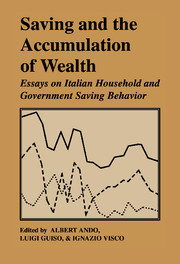Book contents
- Frontmatter
- Contents
- Foreword by Antonio Fazio
- List of contributors
- List of figures
- List of tables
- Acknowledgments
- Introduction
- I Saving trends, government deficit and demographic changes
- II Life-cycle saving and precautionary motives
- III Borrowing constraints, intergenerational transfers and bequests
- Appendixes
- Index
Introduction
Published online by Cambridge University Press: 05 May 2010
- Frontmatter
- Contents
- Foreword by Antonio Fazio
- List of contributors
- List of figures
- List of tables
- Acknowledgments
- Introduction
- I Saving trends, government deficit and demographic changes
- II Life-cycle saving and precautionary motives
- III Borrowing constraints, intergenerational transfers and bequests
- Appendixes
- Index
Summary
Starting in the period between 1970 and 1975, most OECD member countries saw a more or less marked decline in national and personal saving rates. In Italy, the net private saving rate adjusted for inflation and including net investment in consumer durables hovered around 19 percent during the sixties, declined in the seventies and early eighties and has fluctuated around 14 percent since then. This makes the level of the Italian saving rate generally higher than the average for OECD countries throughout this period, but the size of the decline is also greater for Italy than for other countries.
These patterns have given rise to concern about the ability of the economies to accommodate a sufficiently rapid capital accumulation. An increase in the rate of capital accumulation on a global level has been viewed as necessary in order to meet the financial needs of many developing regions, including Eastern Europe, which are to be set on a stable path of economic recovery and development. A reversal of the declining trend of investment in the developed economies has also been called for in order to meet the capital requirements needed to enhance the economic and social welfare and to sustain the rates of growth necessary to reduce the high levels of unemployment, which have prevailed, especially in the European Community, in the last fifteen years (for a most recent contribution on some of these issues, see the collection of papers in Heertje, 1993).
- Type
- Chapter
- Information
- Saving and the Accumulation of WealthEssays on Italian Household and Government Saving Behavior, pp. 1 - 20Publisher: Cambridge University PressPrint publication year: 1994



